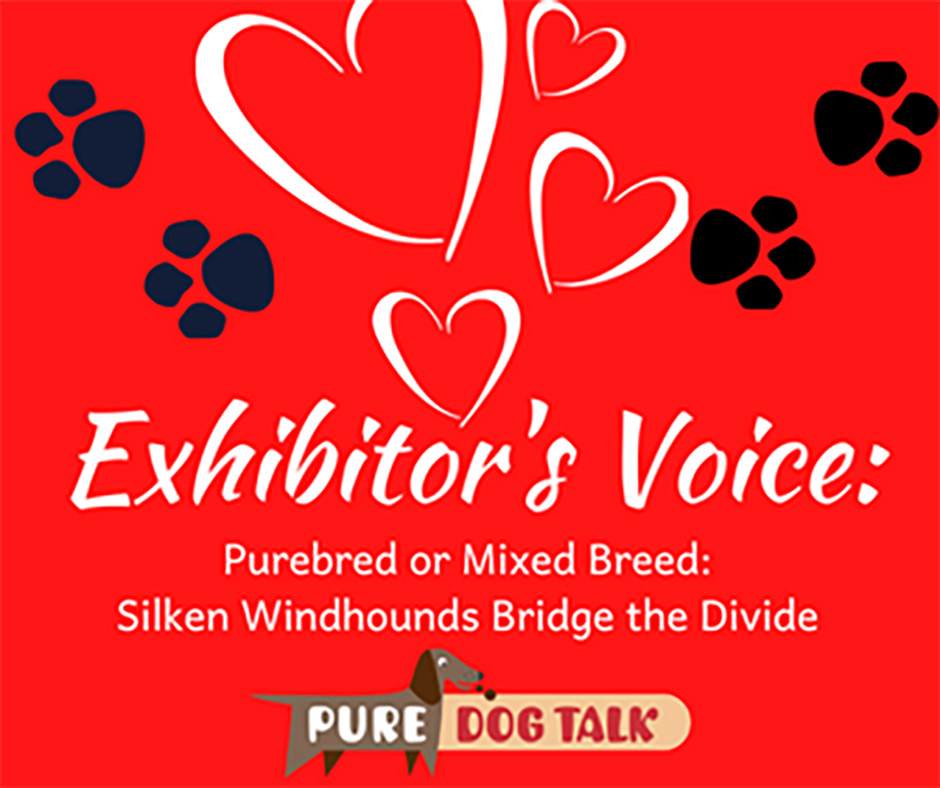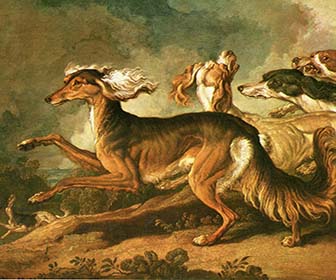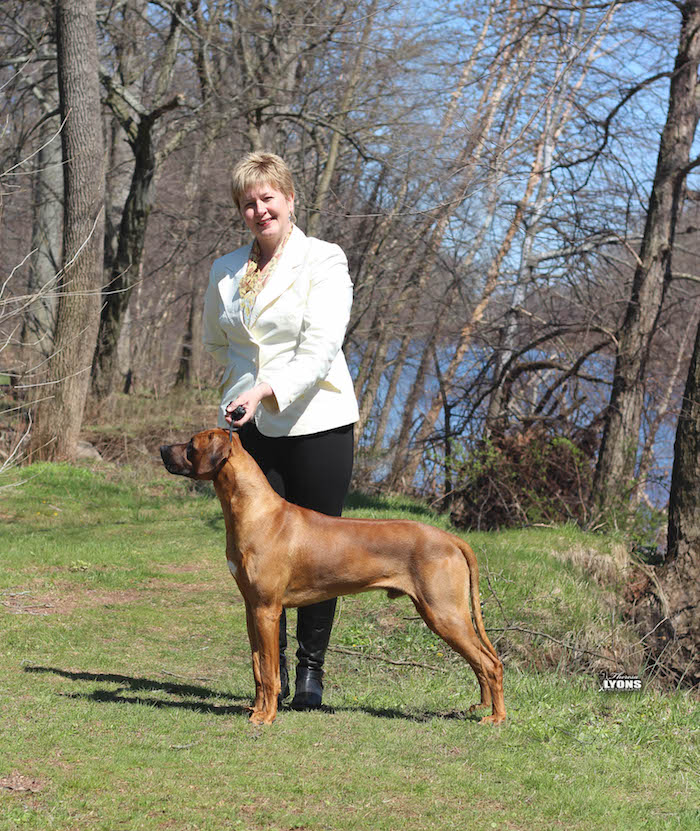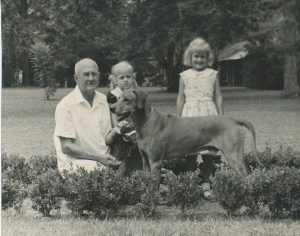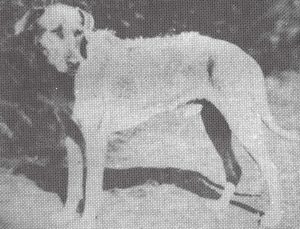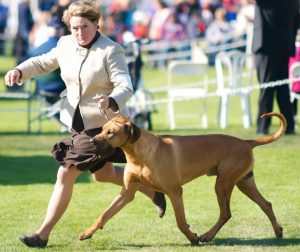603 — Purebred or Mixed Breed: Silken Windhounds Bridge the Divide
Purebred or Mixed Breed: Silken Windhounds Bridge the Divide
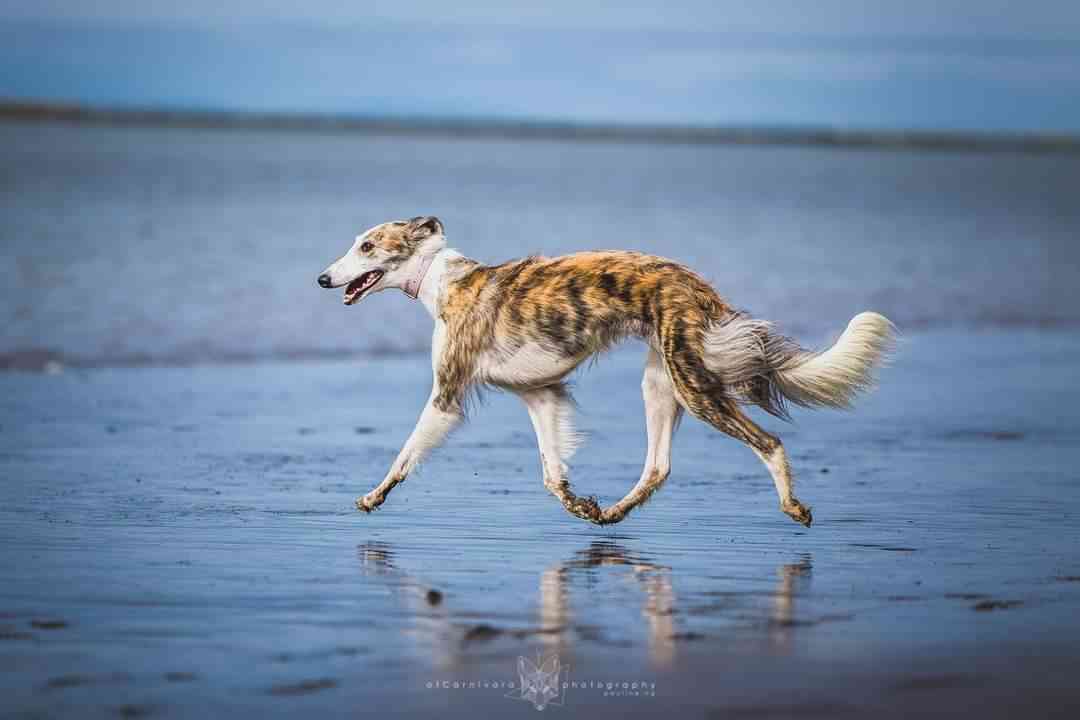
Silken Windhounds descend from lurchers (believed to be Whippet x Sheltie) and Borzoi.
Ashlynn Hill joins host Laura Reeves for a discussion of the Silken Windhound. These dogs appear to bridge the divide between preservation purebred dog breeders and the “fad” mixed breeds that make many preservation breeders tear out their hair.
A partial transcript of the conversation follows.
Pure Dog Talk is the voice of purebred dogs. We talk to the legends of the sport and give you the tips and tools to create an awesome life with your purebred dog. From showing to preservation breeding, from competitive obedience to field work, from agility to therapy dogs, and all the fun in between, your passion is our purpose.
– Welcome to Pure Dog Talk. I am your host, Laura Reeves, and we’re having these conversations. We had a conversation last week about the American bullies and kind of this concept that so few of the breeds that we know today were, as I say, burst from the head of Zeus, right? Most of our dogs that we know were created somewhere along the way. Some of them are more recent and there’s a conversation to be had about these created crosses, why they were created, what the goals are, what the history and the purpose of the crosses are, and how that progress is going into creating a whole new purebred dog.
So I have with me Ashlyn Hill, who is involved in Silken Windhounds. She says she came through the herding breeds to Silken Windhound pipeline, which I think is adorable.
Pure Dog Talk is proudly sponsored by Trupanion, medical insurance for the life of your pet. Trupanion can give you peace of mind knowing your pet is covered in the event of an unexpected accident or illness.
Even better, Trupanion can pay your veterinarian directly and has no payout limits. So you’ll never have to choose between what’s best for your pet and what’s best for your wallet.
And if you’re a breeder, you can join Trupanion’s free breeder support program and get a special offer to share with your puppy buyers that waves all the waiting periods.
So coverage goes into effect immediately.
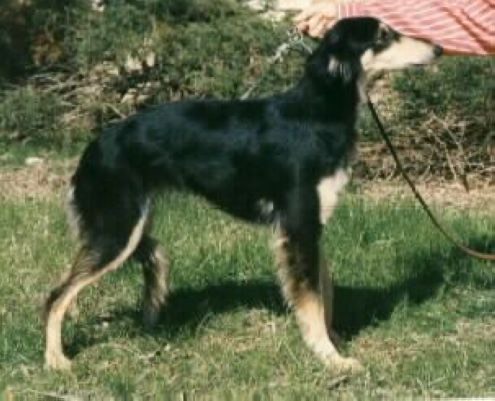
Kristull Amalie – LHW (1984) from Francie Stoll’s A litter.
Yeah. So Silken Windhounds, we’re going back to the very beginning. We’re looking at around the 1980s.
Our breed founder is Francie Stoll. She had a pretty extensive history in Borsoy before she decided to take on this project of making a new breed. So in the early 1980s, she actually got the first dogs that she would use to produce Silkens from Walter Wheeler. Walter Wheeler was well known in the Whippet community for having his long -haired Whippets.
So Walter Wheeler claims that he had, you know, purebred long -haired Whippets. You know, whether that is really true, we don’t really know. We, as Silken People, we say that they were lurchers. We very strongly believe that there were some Sheltie hiding back there because in Silken, we have CEA and MDR1, herding breed, you know. So that’s what our suspicion is. We call them our lurchers.
So Francie got several of these long -haired Whippets from Walter Wheeler. Some of them were in Whelp, and she used those to start making her own thing. I mean, it wasn’t until about 1985 that she says her first litter of Silken Windhounds were born.
This was when she had added in some Borzoi and she finally created the vision of what she was looking for. And really what she was looking to produce with these lurchers and adding the Borzoi and the little bit of the whippet history is that she’s looking for a medium -sized, very elegant, very easy sighthound. You know, just looking to fill that niche for something a little bit smaller, but not quite Italian greyhound sized. So that was really what she was just looking to produce.
And the D litter, the Kristull D litter, is what she says was her first production of Silkens. She made it. This is what she’s looking for. And she took that and continued to breed on from there.
So this is fascinating to me. Is she doing inbreeding, linebreeding, and how is she accomplishing or how is the breed today accomplishing? What is this? 30 years later, the consistency that you expect to see from a purebred dog?
Yes, there was a lot of linebreeding. Mostly there were studs used several times. You know, we’re talking upwards of like 7, 8, 9, 10, 11 times. We’ve got dogs being used. So it was primarily a lot of linebreeding on line breeding in the beginning. But eventually, we were able to create enough diversity to we’re sending Silkens out to Europe. We’ve got Silkens in Canada. We’ve got other breeders participating. You know, once it kind of got bigger than Francie, that’s when, and this is, you know, only the late 90s. That’s when we’re starting to add more.
We’re creating the breed and we’re able to take this and really just continue to breed on to what Francie has produced. And I really think that very early on, they were breeding true. You know, you look at a very early picture of a silken windhound and I can look at that even as a project dog and say,
“That looks like a silken.”
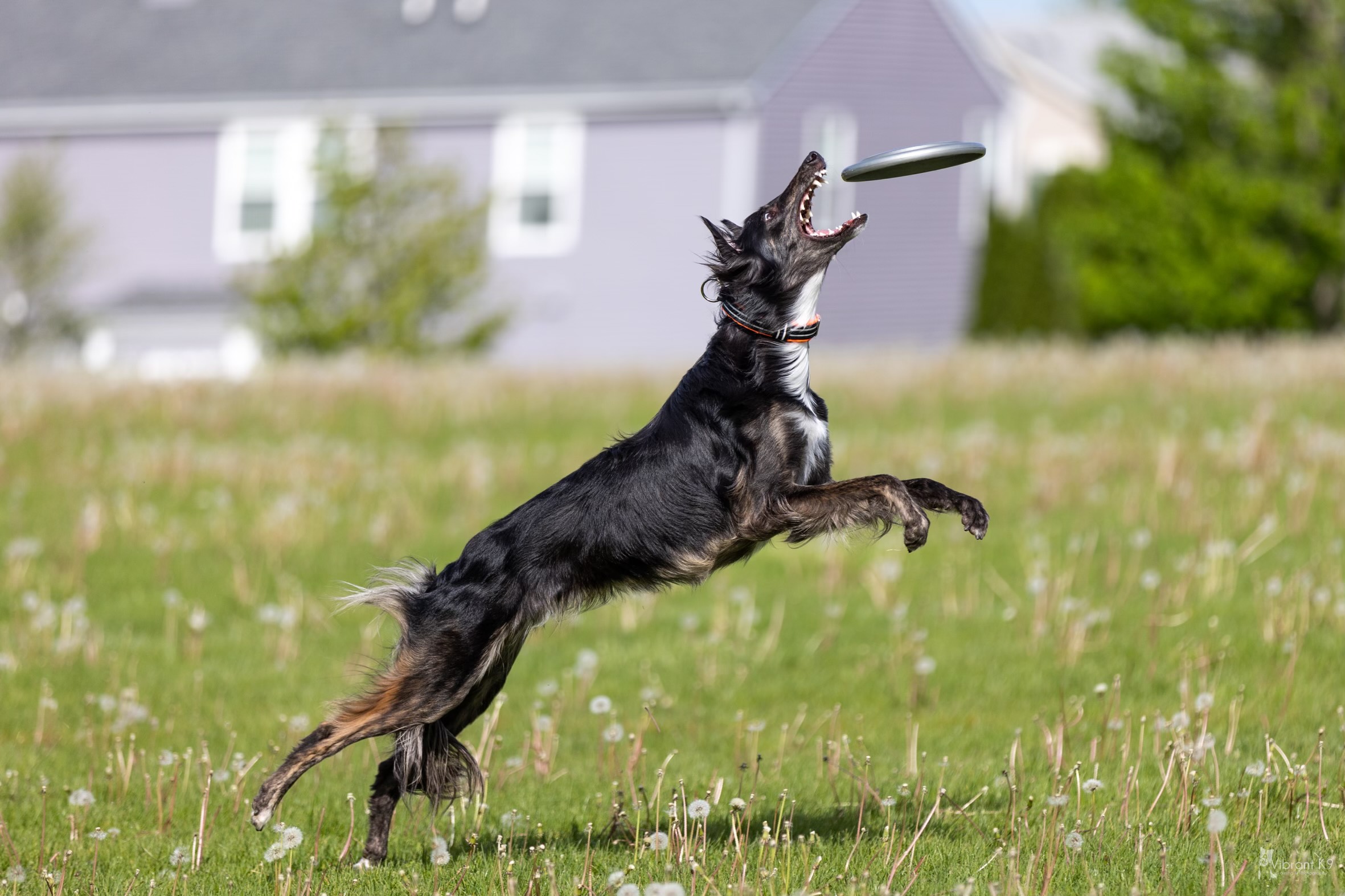
Most Silken Windhound enthusiasts enjoy competing in various sports with their dogs.
And so what makes a silken windhound its breed? So the ones that I’ve seen, I’m kind of like, “Is that an ugly Borzoi? What are we doing?” Right? So talk to me about what makes them their specific breed. What is their breed type?
Yeah. So I think what makes a silken a silken is that size -wise they should be, and typically are, much smaller than a Borzoi. We’re talking about with the size slightly bigger than a Whippet, slightly smaller than a Borzoi. They have very long, easy to maintain coat. Personality -wise, they’re a little more human -oriented, a little more biddable, willing to work. We do have silken, there’s a range. So we have your more sight -hound typical silken where we’re talking like, not a lot of repetition, the training session should be short and sweet. And then we also have silken, and I’ve met several, I have a couple that are just like almost border collie -like, and they’re willing this to work, like just drill and drill and drill.
Interesting. So you see that herding bit coming through.
Yes. And it’s surprising, you know, how much that really seems to, even still, because Sheltie was only ever what was behind Walter Wheeler’s dogs. There has never been any direct cross with Sheltie to Whippet, to Whippet, to Borzoi, like that’s never been in the history of a silken windhound. So it’s just that little bit way back when, and it still really seems to ring true today.
A little bit goes a long way with those guys.
Yeah. Literally.
So you have a club, you have a parent club, yes?
Yes. We have the International Silken Windhound Society. This was founded in 1999. That is kind of where we started to lock everything in. So we’ve got the breed club that’s been produced. We’ve accepted a breed standard, and now we’re kind of really making things officially official.
And do you compete with your dogs in UKC, I think, yes?
Yes. Yep. So we gained UKC recognition or acceptance in 2011. That’s our primary venue for conformation. Some time in the last 10, 15 years.
Yeah. Okay. All right. That’s good. And is there a desire amongst your group of fanciers to compete at the AKC level? Is this something you expect to take forward and to FSS, miscellaneous, and work your way up?
Yes. Yes. Very much much so. I would say a very good chunk of exhibitors in the breed are hoping for AKC acceptance.
Listen in for the rest of this fascinating coversation….
503 – Examining the History of Sighthounds with Bo Bengtson
Examining the History of Sighthounds with Bo Bengtson
Bo Bengtson, author, publisher and Whippet breeder, attended his first dog show in 1958 in his native Sweden. He joins host Laura Reeves for a deep dive into the intricacies of sighthounds.
“It was, right away, like lightning struck,” Bengtson said. “I was 14 years old and I just knew right away that this was what I wanted to devote my life to. It was really fascinating. It was, as someone once said, a combination of zoo and circus and theater …
A passion for sighthounds
“You have to know a little bit about coursing if you’re involved in sighthounds. They have remained the same for thousands of years, the basic type. They weren’t breeds early on but different types of sighthounds. if you look at the early description of coursing which is the pursuit of game with sighthounds … that is a sport that’s now these days illegal in most of US… It’s been superseded by lure coursing, which is an artificial form of coursing.

“Hunters Homeward Bound,” 10th Century AD. Courtesy of Bo Bengston.
“(Sighthounds developed) before firearms basically, when the only way you had to hunt was through the dogs and whatever they could course and kill was basically today’s dinner. Firearms made sighthounds very much superfluous. And I think the sport then became very much a status symbol. (Sighthounds) are of course aesthetically pleasing and so many rich people and aristocratic people preferred to hunt with sighthounds, not because of need but because it was a beautiful spectacle and pretty expensive spectacle too. In various parts of the world, Queen Elizabeth I was very fond of coursing. In Russia they coursed with Borzoi. And in the Far East there were Salukis.
What IS a Sighthound?
“There is no official definition of what a sighthound is. So there is a great disagreement about what breeds actually count as sighthounds. You can count as few as four or five as pure sighthounds and as many as 40 as “sighthound related” or different types of breeds we don’t know in this country. Some we wouldn’t define as breeds but more as types.
(Listen to fascinating conversations about the Caravan Hounds of India here and here.)
History of sighthound development
“I think we have to go back again a couple of thousand years because there have probably always been different sizes of greyhounds. Greyhound types. The big ones which were the ancestor of the modern greyhound. And we have the different, smaller ones that were ancestors of whippet and the Italian greyhounds. I think that Whippets, although they weren’t described as a breed until late 1800s, they have certainly been around much longer. Catherine the Great of Russia had little English greyhounds she called them. And they were very important to her. She nursed them herself and they slept on a pink couch in her bedroom. But whether they’re Italian greyhounds, whether they were whippet, who knows. I mean they were very small and whether Italian greyhounds or whippets, it is kind of irrelevant these days.
“The Greyhound and the Saluki are sort of the “ur” sighthound, what sighthounds are supposed to be like. … if you take one step away from Saluki you get the Afghan Hound, which is a little more powerful. If you take several steps away from the Greyhound, you get the Ibizan Hound and you get the Portuguese Podengo and that kind of thing.”
Listen to the full episode for more detailed insights into all things sighthound.
466 – Borzoi: Epitome of Elegant yet Powerful Hound
Borzoi: Epitome of Elegant yet Powerful
Borzoi breeders Kristina Terra and Corrine Miller join host Laura Reeves to learn more about the powerful, elegant sighthounds made popular by Russian nobility.
Once known as the Russian Wolfhound, the Borzoi’s history provides a fascinating study of the Russian aristocracy.
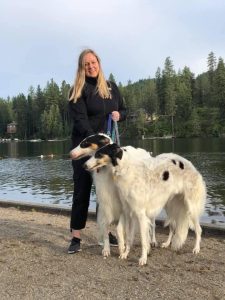 “I think the Russian Wolfhound, it’s a bit of a misnomer,” Terra, president of the International Borzoi Council, said. “Because, actually, the breed in its native land used to hunt many things other than Wolves, but Wolves also. So they were initially bred as a typical sight hound that would hunt the European hare, kind of like a jackrabbit. They’re big in the Russian steppes and the big open spaces but also the forest meadows. So those sighthounds initially had to have a lot of speed on short distances.”
“I think the Russian Wolfhound, it’s a bit of a misnomer,” Terra, president of the International Borzoi Council, said. “Because, actually, the breed in its native land used to hunt many things other than Wolves, but Wolves also. So they were initially bred as a typical sight hound that would hunt the European hare, kind of like a jackrabbit. They’re big in the Russian steppes and the big open spaces but also the forest meadows. So those sighthounds initially had to have a lot of speed on short distances.”
Terra, along with her mother, moved from St. Petersburg, Russia to the United States and acquired their first Borzoi in 1993.
“The first depiction of a Russian wolfhound, Borzoi, is actually at the Saint Sophia cathedral in Kiev, Ukraine,” Terra noted. “It’s one of the frescoes. Since Sophia cathedral dates back to 1037, that is one of the first depictions (of the breed) And also in the illuminated Chronicles of a couple of centuries later, there’s another beautiful depiction of one of the czars hunting with Borzoi. So that’s kind of the second depiction of the breed.
“So the breed goes back ancient and it has changed over the years. Different breeds have been added to it. As the country changed both geographically, you know the forests were cleared, so more stamina was required of a sighthound, the breed changed. Also as the country changed politically, for instance when the serfdom was abolished, when the big aristocratic families of Russia could no longer take care of big kennels, then the breed changed again. But it has always been the symbol of that country and just the epitome of an elegant, yet powerful creature.
“The Royal family is always the one that draws the most attention and just kind of nostalgia, and these beautiful tales and palaces. Of course the Russian czars, they had their own hunt it was the Imperial hunt and it was in the suburb of Saint Petersburg. But one of the biggest breeders and the most famous kennels of the time was actually the czar’s uncle.
“But that was just the czar’s family. There were many Noble families across this vast country and they all considered it their duty to have their own line of beautiful Borzoi and they all competed against each other in how beautiful their Borzoi were, and how fast and agile they were, and how many Foxes or hare or Wolf they could catch.
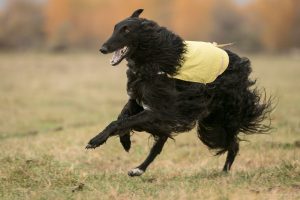 “They would have many kind of field trials, where different neighboring land owners would get together with their dogs and just compare them. The very first written description of the breed appeared in an article in a hunting magazine in 1888. That description was voted on by the Imperial hunting society members. They all voted on that and I suppose that could be called the first standard of the breed.”
“They would have many kind of field trials, where different neighboring land owners would get together with their dogs and just compare them. The very first written description of the breed appeared in an article in a hunting magazine in 1888. That description was voted on by the Imperial hunting society members. They all voted on that and I suppose that could be called the first standard of the breed.”
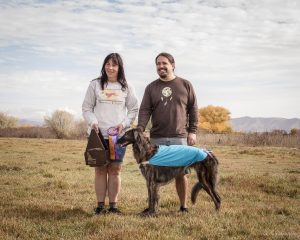 Miller added, “a lot of them (breeders) wrote their own standards, which was interesting. There was one (that was) like ‘oh the black and tan ones are the best’ and then this other guy that lived over the other ways like ‘Oh no, tan markings is bad.”
Miller added, “a lot of them (breeders) wrote their own standards, which was interesting. There was one (that was) like ‘oh the black and tan ones are the best’ and then this other guy that lived over the other ways like ‘Oh no, tan markings is bad.”
349 – Azawakh: The Camp Guardians of the Tuareg People
Azawakh: The Camp Guardians of the Tuareg People
“Nothing Fragile About This Breed at All”
The Azawakh is one of AKC’s newest recognized breeds. The long-legged, aloof hounds have been in the US since 1988, but were only approved for the hound group in January 2019. With only an estimated 150 dogs in the States and less than 3,000 worldwide, Azawakh fall in to the category of “threatened” breed populations.
Aliya Taylor, a retired Philadelphia Police Officer, acquired her first Azawakh in 2012. She grew up in dogs with her family and eventually showed dogs around her police work. Like everyone else in dogs, she scheduled her vacations around dog shows and hoped for no emergencies.
A desert dog, the Azawakh is taller than it is long. They hail from West Africa where they were known as the camp guardians of the nomadic Tuareg people in Mali, Burkina Faso and Niger.
“These guys are basically guard dogs,” Taylor said. Despite appearing emaciated to the untrained eye, “there is nothing fragile about this breed at all. They will guard you and your property.”
“Everything in that part of the world is long on leg, tall off the ground,” Taylor noted. “Azawakh are an evolutionary development. Man had nothing to do with how the Azawakh looks. They are not mixed with any other type of hound and developed independently in an isolated area.
“If you’re fat in the desert, you don’t survive very long,” Taylor added wryly. While she hears a lot of well-intentioned cooing about her “sick or rescued” dog, Taylor said, “They’re supposed to look like this! These dogs eat more than I do. They are physically unable to carry much body fat.”
Taylor encourages judges to approach the breed appropriately.
“You should never approach head on. Approach on an angle, on the side. Keep a calm body demeanor. Put a hand on the dog’s shoulder. Don’t challenge with direct eye contact. Dogs are still primitive & semi feral. Approach cautiously but without fear. Calm, confident, not rushing, no fast hand movements,” Taylor said.
Azawakhs are not the best choice for a first-time dog owner or someone who hasn’t owned a primitive breed.
“They are not Golden Retrievers. They will not be friendly to strangers. They may not be friendly to every person in your home,” Taylor said.
Nonetheless, “These guys are highly trainable. You can teach them to do anything, but you have to get their trust. You have to treat them as an equal. They’re not like other dogs in the sense that you give them a command,” Taylor opined.
248 – LIVE: Laura on Breed Specific Presentation Featuring Sighthounds
Commonalities and Differences in Sighthounds
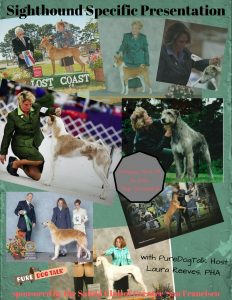
LIVE seminar hosted by the Saluki Club of Greater San Francisco
Live from the Harvest Moon Cluster, your host Laura Reeves talks sighthounds. The seminar was sponsored by the Saluki Club of Greater San Francisco. Watch and listen to the entire seminar here.
Temperament and showmanship are part of breed type. Our job as handlers is to showcase our breed’s character and personality accurately, not make our Wolfhound show like a Doberman. For breeds with less “flash” that might be overlooked in group competition, it is incumbent on us as handlers to provide an engaging, effortless back drop.
Pretty Hands
Our hands tell a story in the show ring. How and where we place our hands on the dog is part of the presentation. Sighthounds specifically call for soft, quiet, elegant hands. Holding the collar, placing the feet, should be done gracefully. Quietly drawing the judge’s eye to our dog’s finest features while using our hands as a “frame,” we actually can “talk with our hands” and subtly communicate with the judge.
Dog handling in general is best done when we are judicious and smooth with our hands. The unique nature of sighthounds means than keeping your hands on the dog at all times will help steady the dog and allow him to be balanced on his own feet.
While showcasing our dogs involves a bit of “sleight of hand” in terms of maintaining emphasis on the good and not the faults, Laura shares her 1-2-3-4-5 hand stacking method as a refresher course. Hear more in depth discussion on this topic in episode 2, “How to Stack Your Dog” or in our new audio book, debuting in January.
Give Your Dog What it Needs: Confidence and Focus
All dogs take their cues from us as the handlers. Sighthounds are particularly in tune with their people and draw their confidence from us. Be sure you are relaxed and enjoying spending time with your dog for your best result.
Moving Gracefully – Float with Your Dog
Drive from the hip and a gradual and collected acceleration are keys to showing the judge your dog’s best movement. Don’t let your dog look like “an octopus on speed” by following these suggestions. More discussion in episode 3 and in the audio book.
Ears and Tails
Each of the sighthounds, and really all dogs, have a correct ear and tail carriage to “make the picture” for the judge. Learn how to work with your dog’s attitude to get the best results.
223 — Rhodesian Ridgeback: Power and Elegance
Balancing act of the Rhodesian Ridgeback
Denise Flaim, Rhodesian Ridgeback breeder, judge and historian, shares her knowledge as the RRCUS 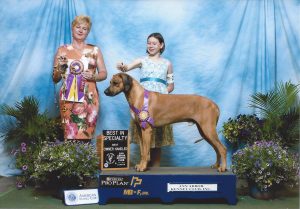 National Specialty kicks off in Colorado.
National Specialty kicks off in Colorado.
The first impression of a Rhodesian Ridgeback, Flaim said, is a “smooth dog with an unbroken fluid line from the top of the head, lovely crested neck, smooth withers, straight topline, gently sloped croup, slightly longer than tall, handy sized for trotting all day. Well angled. Not an empty front, moves freely and effortlessly. Lovely head, round dark eye, triangular ear.”
The Ridgeback, Flaim noted, is that perfect balance of speed and strength. The original dogs routinely coursed large African antelope. As with other sighthounds, the size and bone of the breed always parallels the prey it hunts. They need to be heavy enough to bring down large game like a 200-pound Nyala; lithe and fast enough to catch it. While the breed features a diversity of style within type, the ideal is a dog lacking exaggeration in any part.
“If you don’t know (a breed’s) history you’re doomed,” Flaim said “because you can’t understand its function and morphology.”
Ch. Swahili Jeff Davis — first American champion — with owner and founding Ridgeback breeder Col. Morrie de Pass of Mississippi.
Ridgebacks in Africa
In brief, according to Flaim, when the Dutch went to southern Africa in the late 1600s, they found an unimproved “border collie looking” dog that had a dorsal rise of hair on its back, Flaim summarized. These indigenous dogs that hung out with Koi Koi people, interbred with the Continental dogs, resulting in dogs that had native knowledge, resistance to tse tse flies and more.
The Boers moved to Rhodesia in the late 1800s, and a popular big game hunter acquired ridged bitches and interbred them with his pack. The resulting dogs were excellent at lion hunting.
Flaim was quick to clarify what that actually entailed. The dogs would be taken with rich European hunting parties, in small packs of two or three, to find a lion and harass it, like a matador. Overall athleticism that let the dogs get out of the way of claws was most important.
“Any Ridgeback foolhardy enough to make contact with a lion, soon exited the gene pool in an unceremonious fashion,” Flaim said.
What travels with the ridge?
The breed’s trademark ridge is important, Flaim observed, because “nothing exists in nature if it’s not functional. In Ridgebacks, the dogs that carried the ridge were superlative hunters and could survive in the harsh climate of southern Africa.
“Who knows what native knowledge or traits travel with that ridge,” Flaim said. “For example, Ridgebacks don’t jump into standing pools of water. They want graded entrances. In Africa, if you jump into a standing pool of water you encounter something that wants a snack.”
Rhodesian Ridgeback parent club website: https://www.rrcus.org/
And Allison Foley, Leading Edge Dog Show Academy, tells us how to use cornstarch for dematting.

